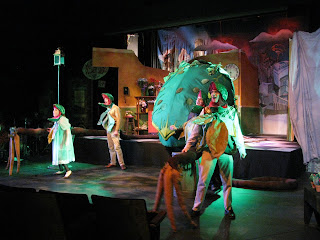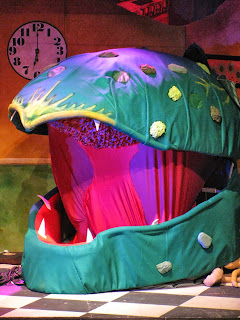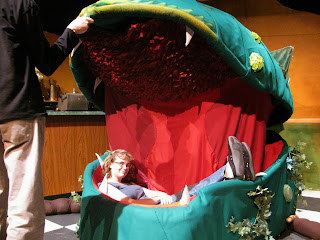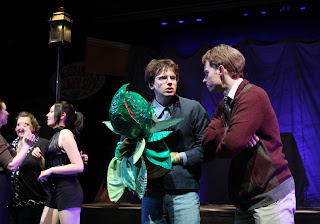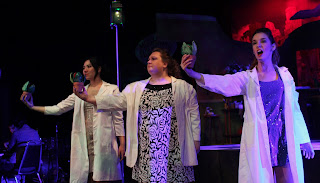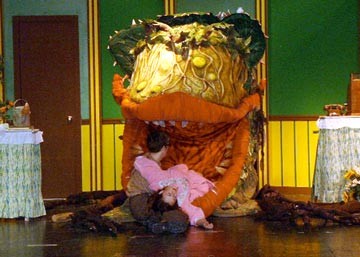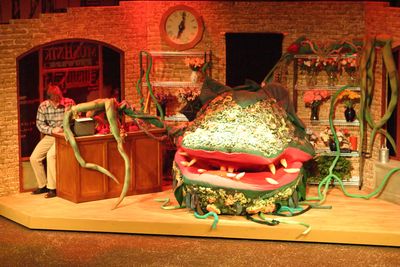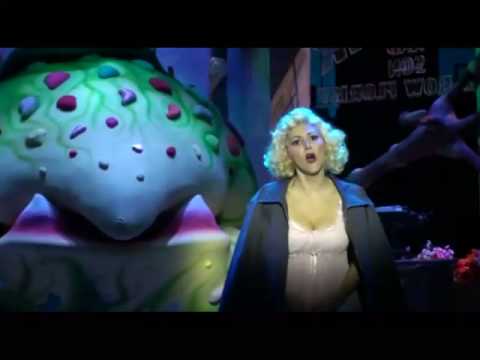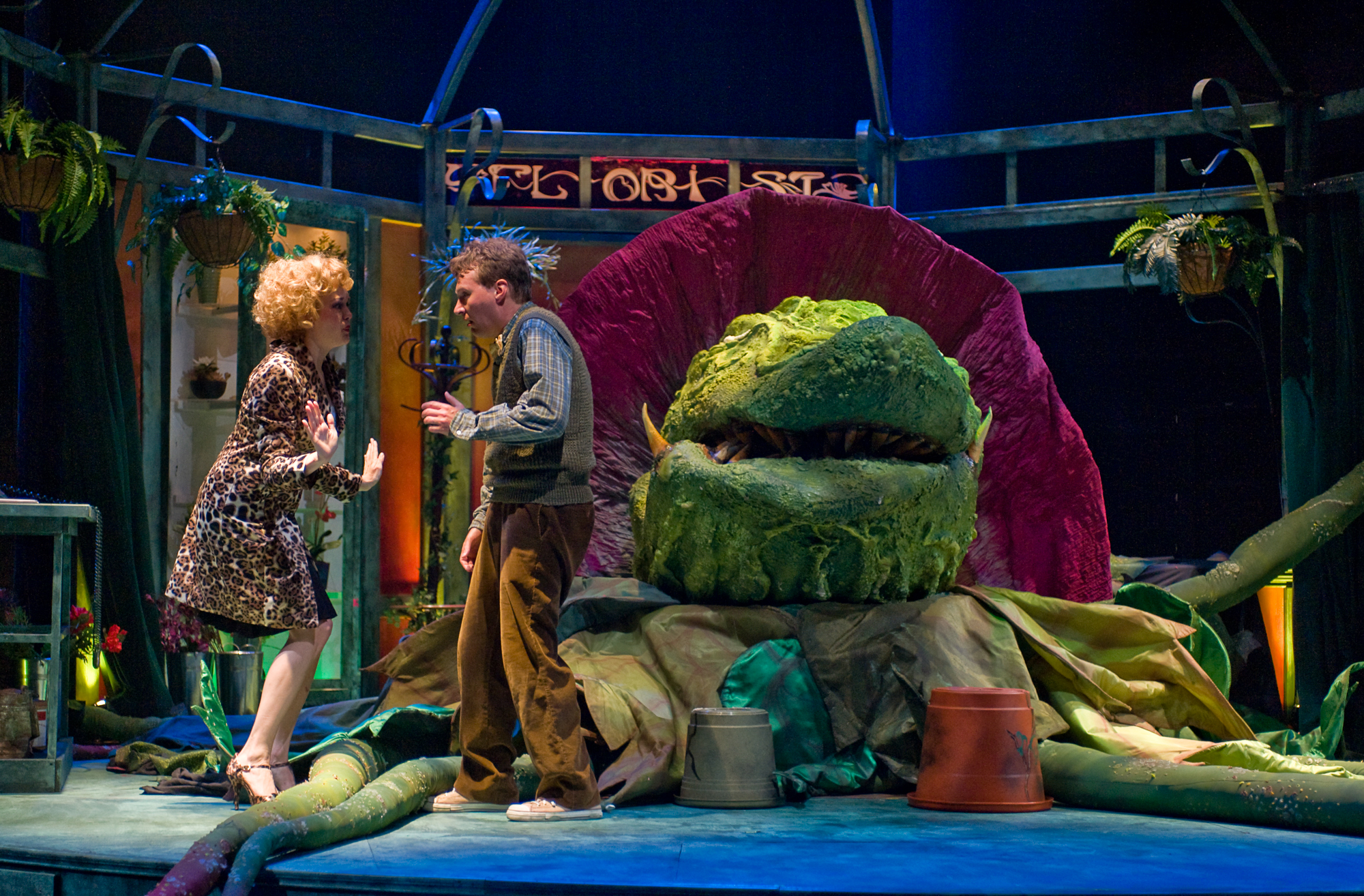- They need to be able to be put on and taken off extremely quickly (Orin only has the first 2 verses of the finale to put his on)
- We wanted ours to open and close. Time constraints made this only marginally effective for us
We once again refer back to our balloon and papier-maché trick. The bloom heads for us were the same size as our Pod 2, so much of the build was the same.
Once the papier-maché was set and cut open, we added some elastic straps into the pod head: for the lower jaw, the elastic went around the neck and was warn like a necklace; for the upper jaw, it went around the head and was warn like a baseball cap. The ideal effect is that the lower jaw sits still on the actors’ chests, and they can close the jaw by lowering their heads. Our lower jaws were a bit, uh, bouncy by showtime. We then just glued in some red fabric around the jaws, cutting a hole for the face to poke through, et voila, blooms.
Our Audrey 1 helps mark the cutout for Orin's face hole in the bloom.
For added effect, we took some large leftover leaves and fashioned some necklaces out of them, to cover up as much of the body as we could, for that extra plant-like look.
- These need to be able to grasp Audrey 1 during Sominex/Suppertime II
- They have to be operated without being seen.
These were pretty simple. The graspers come in 3 sections: The hand, the forearm, and the upper arm (like with human arms). For the forearm, we took some PVC, and covered it with brown fabric, then stuffed the brown fabric with batting, as with previous roots. For the hand, we just added a 90o elbow joint at the end, to give the effect of fingers. For the upper arm, we added an extra length of root fabric, without PVC, going from the elbow to the plant, attaching it to the armature between scenes with a heavy duty carabiner. We had the upper arm go actually go off stage, through the curtain in the shop, so the forearm would stick back in through the same curtain. The arm could then be operate just behind the curtain by holding onto the PVC forearm at the elbow and just lifting or moving it. The PVC had a massive amount of give, but it was sturdy enough that it wouldn’t break. We used our Mushnik to operate it, because a) he wasn’t going to be onstage again til the finale anyways, and b) it was digesting him that allowed Audrey 2 to grow the arm in the first place.
The dotted line is the curtain to backstage, so the handler could grasp the piece of PVC sticking out
We only used 1 arm for the Sominex/Suppertime 2 scene, but we built an additional arm to come onstage for the finale. During the finale, we had one of our “dead” actors hook on the second arm as they came on stage with it. Each actor then grabbed a joint (elbow or wrist on either grasper) and operated them onstage.
Conclusion:
And that’s that! Now you know how we made Audrey 2 at Caltech. The process of making it ready for showtime, which literally took us right up until showtime, was absolutely exhausting. Should you find yourself putting on the a production of Little Shop of Horrors, I highly recommend having a full squad of builders helping right from the beginning, and giving yourself more than a month and a half to build.
Keep an eye out for a video version of this behind-the-scenes making-of, sometime in the near future (hopefully near, but definitely future).
Acknowledgements:
So now I’d like to formally thank those who helped make this possible. In all of theater, there is no part I would rather have played than Audrey 2, so having that opportunity was pretty awesome.
Lead Designers: Sarah Slotznick and Zachary Tobin
Master Welder: Marty Gibbons
Plant Dressing: Kayla Maddox
Executive Construction Assistant: Casey Handmer
Construction Assistants: Holly Bender, Amit Lakhanpal, Doug Smith, Sophie Ballner, Lynne Cooper, Sarah Cooper, Jan Biferno, Mike Biferno, Melissa Biferno, Kim Furuya, Anne Hyvarinen, Alex Jose, Jetson Leder-Luis, Dave Seal, Jeff Sherman, Ben Solish, Miranda Stewart, Christine Sun, Ben Sveinbjörnsson, Phoebe Kellog, Stagehand Andre
Original Voice: David Seal
Original Puppeteer: Zachary Tobin
Part 3: Pod 3
Part 5: Blooms, Graspers, and All the Rest
Turns out, dancing on stage with an extra hundred pounds burns a lot of calories, so we went to Denny's after opening weekend to refill some of them.

